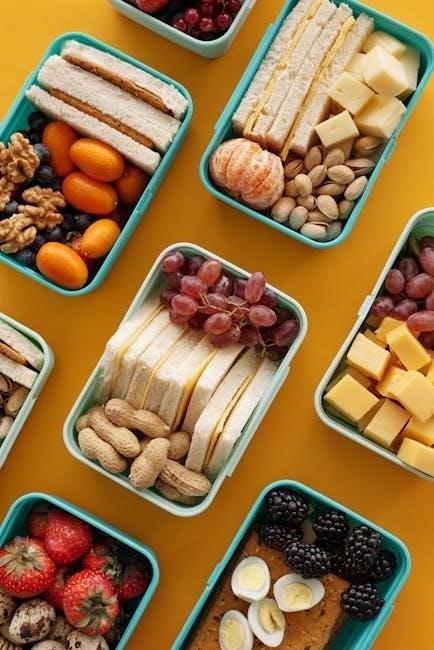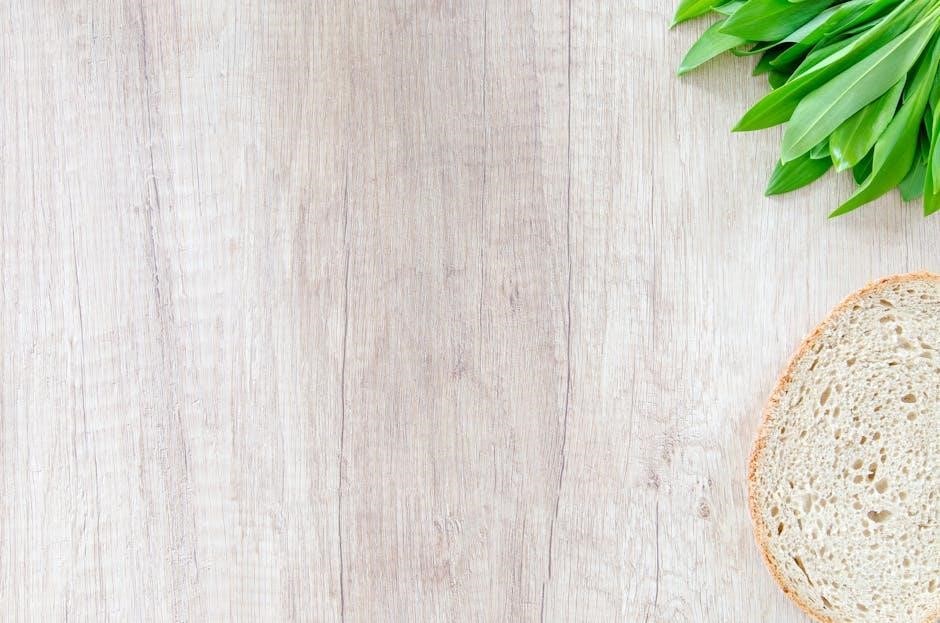The History of Sandwiches
The sandwich’s origins trace back to 18th-century England‚ named after the Earl of Sandwich‚ who requested meat between bread to avoid interrupting his gambling. This practical creation evolved globally‚ adapting to diverse cultures and ingredients‚ becoming a universal culinary staple.
Origins and Evolution
The sandwich’s origins trace back to 18th-century England‚ named after the Earl of Sandwich‚ who requested meat between bread to avoid interrupting his gambling. This practical creation evolved globally‚ adapting to diverse cultures and ingredients‚ becoming a universal culinary staple.
Cultural Impact Across the Globe
The sandwich has become a global culinary phenomenon‚ with adaptations in every culture. From France’s Croque Monsieur to America’s BLT‚ each region adds unique twists. This versatile dish bridges traditions‚ making it a beloved staple worldwide‚ reflecting local tastes and ingredients while maintaining its core appeal of layered flavors and textures.

The Anatomy of a Sandwich
A sandwich’s anatomy consists of base layers like bread and spreads‚ followed by proteins‚ vegetables‚ and cheese‚ finished with condiments. This structure balances flavors and textures.
Base Layers: Bread and Spreads
The foundation of a sandwich begins with bread‚ offering structure and texture. Whether it’s crusty‚ soft‚ or artisanal‚ bread sets the tone. Spreads like mayonnaise‚ mustard‚ or hummus add moisture and flavor‚ creating a base that enhances the overall sandwich experience while balancing its components.
Protein Sources: Meats‚ Eggs‚ and Alternatives
Protein sources form the heart of a sandwich‚ offering versatility and flavor. Options include sliced meats like turkey‚ ham‚ and roast beef‚ fish and seafood varieties such as tuna and salmon‚ eggs for a classic touch‚ and plant-based alternatives like tofu or tempeh. Cured meats like bacon and prosciutto add a savory‚ satisfying element.
Vegetables and Cheese for Texture and Flavor
Vegetables like lettuce‚ tomatoes‚ cucumbers‚ and onions add freshness and crunch‚ while cheeses such as cheddar‚ Swiss‚ and mozzarella provide creaminess and depth. These elements enhance the sandwich’s texture and flavor‚ balancing proteins and condiments for a satisfying bite. They also offer versatility‚ allowing for endless combinations to suit any taste.
Condiments and Sauces
Condiments like mayonnaise‚ mustard‚ and hummus add moisture and flavor‚ while sauces such as ketchup or aioli enhance richness. Jams‚ jellies‚ and chutneys provide sweet and tangy contrasts. These elements elevate the sandwich’s taste‚ offering a balance of creamy‚ spicy‚ or fruity notes to complement other ingredients and create a harmonious flavor profile.

Choosing the Right Bread
Choosing the right bread is essential for a great sandwich. Consider texture‚ flavor‚ and moisture levels to complement fillings. Sourdough‚ baguette‚ or ciabatta can elevate your creation‚ ensuring a perfect balance of taste and structure that enhances the overall sandwich experience.
Types of Bread: From Classic to Artisan
From classic white and whole grain to artisan sourdough‚ baguette‚ and ciabatta‚ the variety of breads offers diverse textures and flavors. Rye‚ multigrain‚ and gluten-free options cater to dietary needs‚ while rustic artisan breads add a gourmet touch‚ ensuring there’s a perfect base for every sandwich creation.
How to Select Bread for Your Sandwich
Selecting the right bread involves considering texture‚ flavor‚ and moisture levels. Opt for sturdy breads like sourdough or ciabatta for hearty fillings‚ while delicate options like white or whole grain suit lighter ingredients. Freshness is key‚ and toasting can enhance crispiness and prevent sogginess‚ ensuring a balanced sandwich experience.

Protein Options
Explore a variety of protein options‚ including meats like turkey‚ ham‚ and roast beef‚ fish‚ eggs‚ tofu‚ bacon‚ and salami‚ offering versatility in flavor and texture.
Meat Choices: Turkey‚ Ham‚ Roast Beef
Turkey‚ ham‚ and roast beef are classic protein choices‚ offering versatility in sandwiches. Turkey provides lean flavor‚ ham adds a savory touch‚ and roast beef brings hearty richness. Each pairs beautifully with condiments‚ cheeses‚ and vegetables‚ creating balanced and satisfying combinations for any palate.
Fish and Seafood: Tuna‚ Salmon‚ Shrimp
Fish and seafood add fresh‚ oceanic flavors to sandwiches. Tuna salad‚ salmon fillets‚ and shrimp are popular choices‚ offering versatility and richness. Paired with greens‚ mayo‚ or tangy sauces‚ they create refreshing‚ protein-packed options perfect for light or gourmet meals‚ appealing to seafood lovers worldwide.
Eggs and Tofu for Vegetarian Options
Eggs and tofu are versatile vegetarian options for sandwiches. Eggs can be boiled‚ fried‚ or scrambled‚ adding protein and creaminess. Tofu can be marinated‚ baked‚ or grilled‚ offering a meaty texture. Both options provide flexibility and flavor‚ catering to various tastes and dietary preferences‚ perfect for creative recipes.
Cured and Cooked Meats: Bacon‚ Salami
Cured and cooked meats like bacon and salami add bold flavors and textures to sandwiches. Bacon offers a smoky‚ savory bite‚ while salami provides a spicy‚ meaty depth. Both are versatile‚ pairing well with cheeses‚ vegetables‚ and spreads to create balanced‚ flavorful combinations that elevate any sandwich.
Spreads and Condiments
Spreads and condiments like mayonnaise‚ mustard‚ and hummus add flavor and texture. Jams‚ jellies‚ and chutneys provide sweetness‚ while herbs and sauces enhance depth‚ making sandwiches more delicious.
Mayonnaise‚ Mustard‚ and Hummus
Mayonnaise adds creaminess‚ while mustard provides tangy flavor. Hummus offers a healthy‚ earthy alternative. These spreads elevate sandwiches‚ balancing flavors and textures. Use mayo for richness‚ mustard for zing‚ or hummus for a vegan twist‚ enhancing everything from classic turkey to veggie-packed creations.
Jams‚ Jellies‚ and Chutneys
Jams and jellies add sweet‚ fruity notes‚ while chutneys bring tangy‚ spicy flavors. These spreads complement meats‚ cheeses‚ and vegetables‚ adding depth and balance. Use them sparingly to enhance classic combinations or create bold‚ adventurous sandwiches with a mix of textures and tastes.
Herbs and Sauces for Added Flavor
Fresh herbs like basil‚ parsley‚ or cilantro add vibrant‚ aromatic notes‚ while sauces such as aioli or tahini provide creamy richness. Experiment with global flavors like sriracha mayo or tzatziki for a zesty kick. These additions elevate sandwiches‚ balancing flavors and textures for a more satisfying bite.

Vegetarian and Vegan Options
Vegetarian and vegan sandwiches offer endless creativity‚ using fresh vegetables‚ plant-based proteins‚ and dairy-free spreads. These options cater to diverse dietary needs‚ inspiring flavorful and satisfying meals for both vegans and vegetarians alike.
Layering Vegetables Creatively
Layering vegetables creatively enhances both texture and flavor. Start with crisp greens like spinach or kale‚ then add sliced cucumbers‚ bell peppers‚ or avocado for creaminess. Incorporate roasted or grilled vegetables for depth‚ and finish with a sprinkle of fresh herbs. This method ensures a vibrant‚ balanced sandwich that delights the senses.
Plant-Based Proteins and Cheeses
Plant-based proteins like tofu‚ tempeh‚ and seitan offer versatility in sandwiches‚ while vegan cheeses such as mozzarella and feta alternatives add creaminess. Marinated grilled portobellos or roasted eggplant provide hearty‚ flavorful options. These ingredients not only cater to dietary preferences but also elevate sandwiches with rich‚ satisfying textures and bold flavors.
50 Mouthwatering Veggie and Vegan Recipes
Discover vibrant veggie and vegan sandwich creations‚ from avocado and hummus delights to grilled vegetable masterpieces. Explore plant-based twists like vegan mozzarella paninis and eggplant parmesan sandwiches. These recipes showcase fresh flavors‚ hearty textures‚ and creative combinations‚ offering something for every taste and dietary preference‚ all crafted with simplicity and flair.
Cheeses in Sandwiches
Cheeses like cheddar‚ Swiss‚ and mozzarella add rich flavors and creamy textures‚ enhancing sandwiches. They can be melted for gooey delight or used as fresh slices‚ complementing meats and vegetables perfectly.
Popular Cheeses: Cheddar‚ Swiss‚ Mozzarella
Cheddar adds sharpness and depth‚ Swiss offers creaminess with a nutty flavor‚ and mozzarella provides mild freshness. These cheeses enhance sandwiches with distinct textures and flavors‚ making them versatile for various fillings‚ from meats to vegetables‚ and are often melted for added richness.
How Cheese Enhances Flavor and Texture
Cheese elevates sandwiches by adding rich‚ savory flavors and creamy textures. It melts smoothly‚ binds ingredients‚ and enhances the overall taste. From sharp cheddar to nutty Swiss or fresh mozzarella‚ cheese complements meats‚ vegetables‚ and spreads‚ creating a harmonious balance that transforms a simple sandwich into a satisfying meal.
Paring Cheese with Meats and Vegetables
Cheese beautifully complements meats and vegetables‚ enhancing their flavors and textures. Cheddar pairs perfectly with turkey or ham‚ while Swiss melts effortlessly with roast beef. Mozzarella adds creaminess to fresh vegetables like spinach or tomatoes‚ creating a balanced and delicious harmony in every bite.
Assembling the Perfect Sandwich
Assembling the perfect sandwich involves layering ingredients thoughtfully‚ starting with protein‚ followed by vegetables‚ cheese‚ and condiments‚ ensuring each bite offers a harmonious balance of flavors and textures.
Layering Ingredients for Optimal Taste
Layering ingredients is crucial for a balanced sandwich. Start with a base of spreads or condiments to enhance flavor‚ followed by protein‚ crisp vegetables‚ and cheese for texture. Finish with fresh herbs or greens to add brightness. This order ensures each bite delivers a harmonious mix of flavors and textures without overwhelming the palate.
Techniques for Even Distribution
Ensure even distribution by layering ingredients uniformly. Use spreads or condiments as a base to prevent sogginess. Tight wrapping or pressing helps maintain shape and balance. For hot sandwiches‚ toasting can enhance texture and distribute flavors evenly‚ ensuring each bite is consistent and satisfying.
Presentations: Cutting and Serving
Present your sandwich artfully by cutting it diagonally or into even halves. Use a sharp knife to avoid tearing the bread. Serve on a clean plate or board‚ garnished with fresh herbs or side salads for an appealing visual finish. Clean presentation enhances the dining experience.
Storage and Transportation
Proper storage and transportation ensure sandwiches remain fresh. Use airtight containers or wrap tightly in plastic wrap or aluminum foil. Store in a cool‚ dry place.
Keeping Sandwiches Fresh
Store sandwiches in airtight containers or wrap them tightly in plastic wrap or aluminum foil to maintain freshness. Keep them refrigerated at a cool temperature to prevent spoilage. For optimal freshness‚ assemble sandwiches just before serving and use fresh‚ high-quality ingredients. Proper storage ensures sandwiches remain crisp and flavorful for a longer period.
Using Containers and Lunch Boxes
Use airtight containers or lunch boxes with insulation to keep sandwiches fresh and cool. Opt for leak-proof designs to avoid sogginess and ensure easy portability. These containers maintain the integrity of ingredients‚ offering a convenient and fresh meal solution for on-the-go enjoyment.
Preventing Sogginess and Stale Bread
Wrap sandwiches tightly in plastic wrap or aluminum foil and store in airtight containers to maintain freshness. Use lunch boxes with ice packs to keep ingredients cool and prevent sogginess. Toasting bread before assembling can also reduce moisture absorption‚ ensuring crispy texture and freshness throughout the day.
Popular Sandwich Recipes
Discover iconic creations like the Classic Club‚ Gourmet Grilled Cheese‚ and Ultimate Veggie Delights. These recipes offer a perfect blend of flavors‚ textures‚ and simplicity‚ satisfying every craving.
Classic Club Sandwich
A beloved triple-layered dish featuring turkey‚ crispy bacon‚ fresh lettuce‚ tomato‚ and mayonnaise‚ served on toasted bread for a satisfying crunch. Perfect for lunch or casual dining‚ its hearty flavors and textures make it a timeless favorite.
Gourmet Grilled Cheese
A sophisticated twist on a classic‚ featuring artisanal bread‚ melted truffle gouda‚ caramelized onions‚ and fig jam. This indulgent sandwich combines rich‚ savory‚ and sweet flavors‚ offering a comforting yet elegant meal perfect for any time of day.
Ultimate Club and Veggie Delights
Elevate your club sandwich with fresh veggies like crisp lettuce‚ juicy tomatoes‚ and creamy avocado‚ paired with grilled chicken or tofu for a hearty twist. Layered with hummus or mayo on whole-grain bread‚ this version offers a satisfying blend of textures and flavors for a nutritious‚ filling meal.
